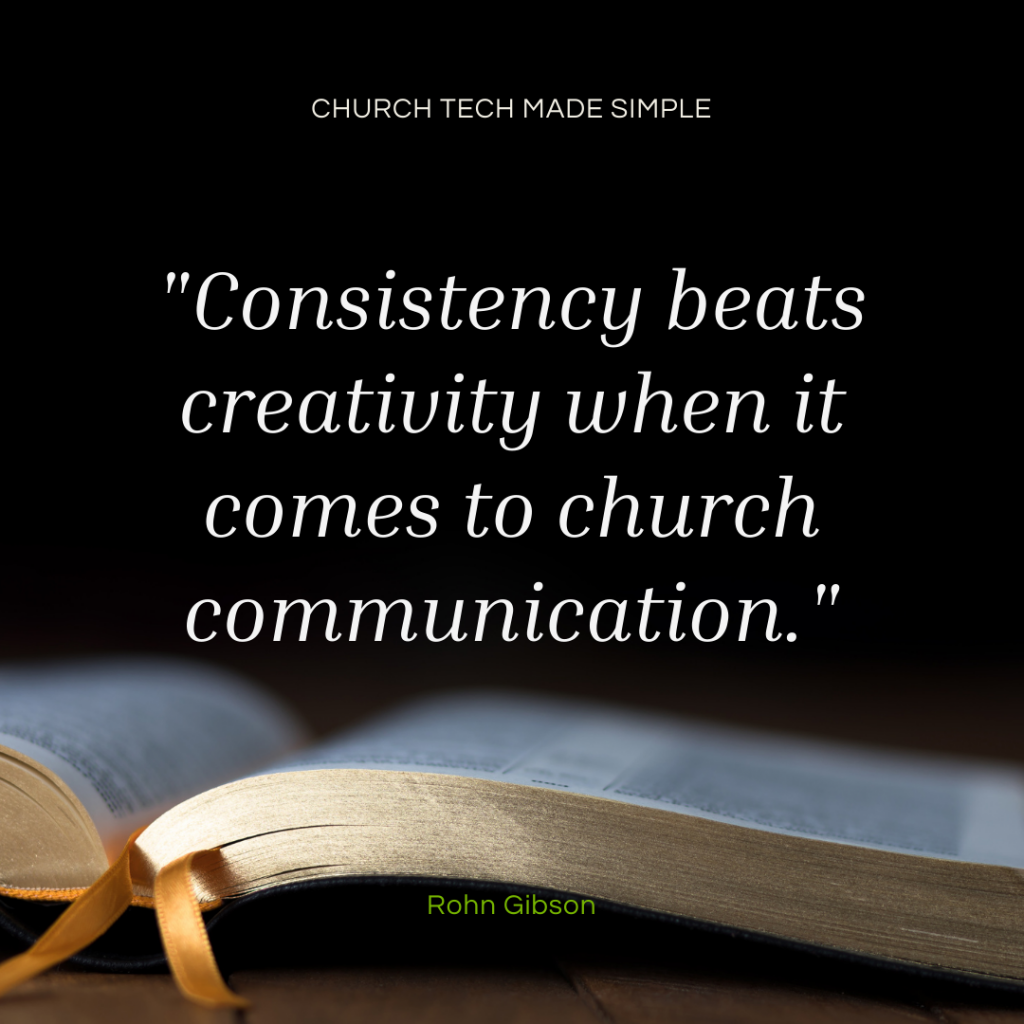If there’s one area where church tech can save you time, reduce stress, and amplify your mission—it’s communication.
Every church is already communicating. The question is: Is your communication clear, consistent, and connected to your mission?
Whether it’s Sunday bulletins, weekly emails, social media updates, or text messages—every message is an opportunity to invite, encourage, and disciple.
“Let your speech always be gracious, seasoned with salt, so that you may know how you ought to answer each person.”
—Colossians 4:6 (ESV)
But for most churches, communication feels scattered. You’re juggling too many channels, saying too much or not enough, and wondering why people still don’t know what’s going on.
This chapter will help you simplify the chaos. You’ll learn how to:
-
Use fewer tools more effectively
-
Establish weekly rhythms that serve both your team and your people
-
Create messages that actually get seen (and acted on)
Let’s start with a mindset shift.
Communication Is Discipleship
Church communication isn’t just about announcements—it’s about alignment.
Every message you send reinforces what your church values, what matters most, and what people should do next. When done with clarity and consistency, communication becomes one of your greatest tools for discipleship.
-
A well-timed text message says, “We care.”
-
A focused email says, “We’re prepared.”
-
A simple bulletin says, “You belong here.”
Whether it’s digital or analog, communication shapes culture.
“A word fitly spoken is like apples of gold in a setting of silver.”
—Proverbs 25:11 (ESV)
The Three Layers of Church Communication
There are three primary layers every church should use consistently:
-
-
Platform Communication
Website, app, and in-service slides. These are your always-available, always-visible messages. -
Direct Communication
Email and text. These go straight to your people’s inboxes or phones and should be used purposefully. -
Social Communication
Facebook, Instagram, YouTube, etc. These are for broader awareness, engagement, and outreach.
-
When these three layers work together, your people stay informed without being overwhelmed.
Simplify Before You Multiply
The biggest mistake churches make? Trying to be everywhere all at once.
Don’t try to master every platform. Start with what works:
-
Pick one email system like ChurchSpring Messaging
-
Use one texting tool
-
Choose one social platform based on your audience (Facebook, Instagram, YouTube, etc.)
Master one channel at a time before expanding.
A Weekly Communication Rhythm That Works
Here’s a simple rhythm many churches use to streamline their messaging:
Monday: Email Newsletter
-
Include no more than 3 calls to action
-
Focus on what’s coming up, not everything that’s happening
-
Link to your website for more info
Wednesday: Text Reminder
-
Remind people about small groups, prayer night, or weekend service
-
Keep it under 160 characters
Friday: Social Post
-
Highlight Sunday’s topic, kids ministry, or an upcoming event
-
Use a photo of real people from your church
Sunday: In-Service Slide Loop
-
Include 2–3 rotating slides before/after service
-
Don’t overload. Simplicity increases clarity
The Rule of One
Here’s a key principle for effective communication:
One message. One audience. One next step.
Instead of trying to communicate everything to everyone, tailor your message:
-
Who is this for? (first-time guests, parents, small group leaders?)
-
What’s the one thing they need to know?
-
What’s the one step they should take next?
When everything is a priority, nothing is.
Common Communication Mistakes to Avoid
-
Too Many Platforms: You don’t need to start with a podcast, blog, email, app, Instagram, YouTube, and weekly mailer all at once. Choose two or three that align with your people.
-
No Consistent Rhythm: If people don’t know when or how to expect updates, they’ll miss them.
-
Vague Messaging: “Join us this weekend!” is less effective than “Join us this Sunday at 9:00 & 10:45am for a new series: How to Walk by Faith.”
A Quick Win: Create a Communication Checklist
Make a simple checklist for each week:
-
Send email with top 3 updates
-
Schedule 1–2 social posts
-
Text or email group leaders midweek
-
Update homepage with current sermon or event
-
Refresh announcement slides
When communication is planned, it’s peaceful.
Final Thoughts
Church tech isn’t just about tools—it’s about truth.
And in today’s distracted world, clear communication is one of the best ways to love your people well.
You don’t need to be clever. You just need to be consistent.
You don’t need a megachurch media team. You need a plan that works for your church.
With a few simple tools and a faithful rhythm, you’ll stop the chaos and start leading with clarity.
“The heart of the wise makes his speech judicious and adds persuasiveness to his lips.”
—Proverbs 16:23 (ESV)
FAQS
Our members still miss important updates—what are we doing wrong?
Most likely, your messages are scattered across too many platforms or lack consistency. Establish one central hub (like your website or a weekly email) and repeat your key announcements there. Repetition and rhythm create clarity.
Do we really need to use email, text, and social media? Isn’t that overkill?
Each channel serves a different purpose. Email is for depth, text is for immediacy, and social media is for awareness. You don’t have to do them all at once—start with one or two, then expand as your team can handle it.
How can we avoid overwhelming our congregation with too much info?
Use the Rule of One: one message, one audience, one next step. Instead of trying to communicate everything at once, focus on clarity. People are more likely to act when they know exactly what to do next.
What’s a realistic communication rhythm for a small church with limited staff?
Keep it simple with one weekly email with 2–3 key updates, one text reminder midweek, one social post highlighting Sunday’s service, and wo or three in-service slides. Consistency matters more than volume.
How do we know which social platform to focus on?
Choose based on where your people already are. If your members mostly use Facebook, start there. If you’re reaching younger families or students, Instagram or YouTube may be better. Don’t try to do all of them—master one before adding another.
This blog is an adaptation of Chapter 3 from ChurchSpring Co-Founder Rohn Gibson’s new book Church Tech Made Simple, coming Fall 2025.
Related Blogs:
The Mission Comes First with Church Tech








